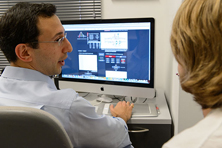New Interactive Program Developed for Visualizing Protein and DNA Sequences

A team of researchers from University of Connecticut and Harvard Medical School have developed a new web program for visually analysing DNA and protein sequences. This new program, called probability logo (pLogo) is an interactive program that creates graphical representation of nucleotides and amino acids by creating a series of scaled colour coded letters representing the biological residues that are part of the molecules whose motifs are being visualized. The size of each letter is an indication of the relative significance of the biological residue occurring in that position in a motif.
Development of pLogo is the result of collaborative effort by several computer science and engineering students from University of Connecticut to realize the algorithm conceived by Daniel Schwartz, the research team leader along with Michael Chou from Harvard Medical School. pLogo scores over other open access logo generators available out here in many ways. For starters, pLogo can automatically generate background data sets for the entire protein set of an organism by making use of the foreground data set collected from it. This will help researchers determine the significance of data sets generated in the lab. pLogo also allows researchers to interact with motif in real time to generate specific statistic information and new visualizations. It also takes care of the inconsistencies in the data and proposes suitable parameters for analysing them. Further information about this project can be found in Nature Methods.
Source: University of Connecticut

